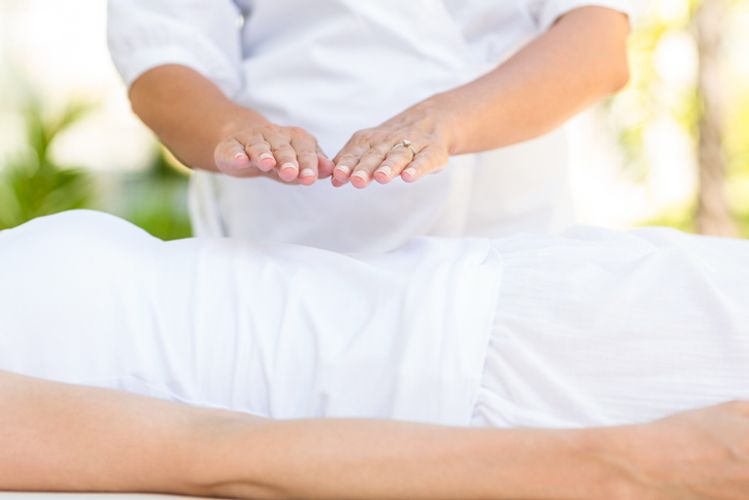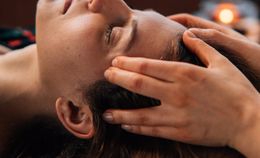Reiki is a spiritual healing art usually credited to Dr. Mikao Usui in 1930s Japan. It takes a holistic approach to supporting health and wellness, and is supported by numerous scientific studies in its safety and efficacy.
Reiki is a form of energy work, in which the practitioner uses their hands to redirect and rebalance the universal life energy known as qi or ki, within and surrounding the recipient's body. This supports the individual's capacity for self-healing.
Reiki is typically performed while the recipient lies fully clothed on a comfortable treatment table (similar to a massage table) or as they sit in a chair. Sometimes tight touch is applied to the body; in other cases the healer holds their hands just above the client's body in several locations throughout a session.
Reiki does not treat specific symptoms or health conditions; rather, it works to strengthen and balance ki, the vital life-force energy that all living beings possess. When ki flows are strong and free-moving, the body and mind can often heal injury and illness themselves and better tolerate and recover from pain, stress, and discomfort.
Read on to learn more about the fundamentals of Reiki practice, the science behind Reiki, and the benefits of Reiki in supporting health and well-being.
Reiki basics
Reiki may seem somewhat mysterious at first. As a spiritual healing practice, Reiki's precise mechanisms are not fully known or understood. However, this bit of mystery has no bearing on Reiki's healing power, which is gaining in popularity for good reason.
The public is increasingly seeking the benefits of Reiki for improved health and wellness, recognizing the power of caring touch and the value of a holistic approach. Conventional health care institutions are following suit, adding Reiki healers to their staff to provide this important additional tool for patient wellness and recovery, recognizing its benefits alongside exercise and nutrition to support better health and well-being over time.
Each Reiki practitioner practices differently. Reiki treatment can encompass a range of techniques from different strains and traditions. However, the practice always involve the healer's use of their hands to support restoration of strong and healthy energy flows in the recipient.
A mentioned above, this can involve light touch or in case of emotional or physical sensitivity, by hovering the hands just above the recipient's body. This approach can also be used if that is preferred by either the Reiki practitioner or the recipient.
A Reiki session generally lasts from 30 minutes to as long as 90 minutes, with shorter options available when circumstances require (for example, in busy inpatient settings). The healer holds their hands in place for several minutes at a time on or over different locations on a recipient's body, including the head, torso, and sometimes the limbs. Different hand positions are often used. The recipient remains fully clothed.
Reiki is usually offered in a relaxing environment, with cushioned furniture and loose, comfortable clothing preferred for the recipient, to put them most at ease. The temperature of the room should similarly be comfortable and a blanket should be offered if needed. Some Reiki healers and clients prefer silence; others enjoy quiet background music be played throughout a session.
Details of the Reiki session should be discussed in advance so that the healer and recipient are both comfortable and confident with the experience they are about to embark on together. Open communication is always encouraged to best meet a client's needs and goals.
The science of Reiki
Western medical research is still in the early stages of documenting and explaining the healing effects of Reiki practice. However, many studies already support the safety and effectiveness of Reiki. This, coupled with the increasing popularity of Reiki, is leading many mainstream healthcare providers to include Reiki as part of a full suite of integrative medicine services.
Here is what some of the scientific research is saying about Reiki's benefits for holistic health and wellness:
- Recipients of Reiki experience measurable autonomic nervous system changes compared to placebo control groups and those not receiving Reiki treatment, including significantly lower diastolic blood pressure and heart rate.1
- There is strong evidence for Reiki as an effective method for reducing pain intensity in hospitalized and non-hospitalized patients. Reiki treatment has also been shown to reduce anxiety among hospital patients and to reduce negative behavioral symptoms associated with dementia.2 Numerous studies generally support the effectiveness of Reiki in alleviating pain and anxiety.3
- Biofield therapies involving healing energy treatment, including Reiki, have been shown to improve quality of life, reduce pain, and help improve emotional well-being through stress reduction for patients in hospice care.4
- Reiki is a promising, low-cost therapy for patients with mild Alzheimer's disease and mild cognitive impairment, improving memory and behavior problems. One study even cited the "significant societal value" of Reiki owing to its potential to reduce the need for medication and hospitalization.5
- Reiki is a safe, gentle, and effective complementary therapy with broad potential to help manage a wide range of chronic health conditions and assist in recovery from surgery. Treatment "activates the parasympathetic nervous system to heal body and mind".6
- Conventional healthcare workers showing symptoms of "burnout" - emotional exhaustion, depersonalization, and reduced personal accomplishment - improved markedly immediately following Reiki treatment. This study also adds to the evidence that Reiki has measurable effects on the autonomous nervous system, including cortisol levels and heart rate variability.7
The benefits of Reiki
Reiki energy healing supports recovery and wellness by treating the whole system holistically - body, mind, and spirit.
Strengthened energy flows allow a system to better heal itself. The Reiki practitioner helps boost this process when there is a blockage, weakness, or stagnant ki. Following a series of Reiki sessions, the recipient will begin to experience stronger life force energy and more balanced circulation of ki throughout the body, promoting the natural self-healing power that all living beings already possess.
Mental and physical pain and injury may heal more rapidly with Reiki. The body may be less prone to illness. The mind may be less vulnerable to worry and negative emotions. Stress may be reduced. An overall greater sense of well-being will prevail.
These factors can all play a role in healing from physical and mental trauma and maintaining good health. For this reason, Reiki is often used by those facing serious medical challenges, suffering from chronic pain, or struggling with mental health problems like depression, anxiety, chronic stress, insomnia, and more.
References:
1 "Autonomic nervous system changes during Reiki treatment: a preliminary study": https://www.ncbi.nlm.nih.gov/pubmed/15674004
2 "Biofield therapies: helpful or full of hype? A best evidence synthesis": https://www.ncbi.nlm.nih.gov/pubmed/19856109
3 "Effect of Reiki therapy on pain and anxiety in adults: an in-depth literature review of randomized trials with effect size calculations": https://www.ncbi.nlm.nih.gov/pubmed/24582620
4 "Biofield therapies for symptom management in palliative and end-of-life care": https://www.ncbi.nlm.nih.gov/pubmed/24259404
5 "Using Reiki to decrease memory and behavior problems in mild cognitive impairment and mild Alzheimer's disease": https://www.ncbi.nlm.nih.gov/pubmed/17109583
6 "Reiki Is Better Than Placebo and Has Broad Potential as a Complementary Health Therapy": https://www.ncbi.nlm.nih.gov/pubmed/28874060
7 "Immediate effects of Reiki on heart rate variability, cortisol levels, and body temperature in health care professionals with burnout": https://www.ncbi.nlm.nih.gov/pubmed/21821642





















